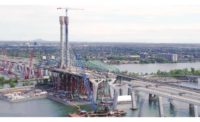An investigation is underway into a crane collapse at the site of the new Tappan Zee Bridge in New York.
The boom of a Manitowoc MLC300 lattice-boom crawler crane collapsed near midday on July 19, crashing down onto the active roadway of the old Tappan Zee Bridge. No serious injuries were reported, but traffic was snarled for hours while structural engineers inspected the old bridge for damage. A vital part of the New York State Thruway, the Tappan Zee Bridge carries over 138,000 cars per day.
“One of the cranes was operating a vibratory hammer, and it had an issue, and it caused the crane to collapse across both sides of the old Tappan Zee Bridge,” said New York Gov. Andrew Cuomo (D) in a July 19 press conference held shortly after the collapse. The site of the New NY Bridge has brought dozens of mobile and barge-mounted cranes to the waters of the Hudson River; according to Cuomo, the collapsed crane was just one of 28 cranes that were operating on the site that day.
“The crane that fell was a new crane. Fortunately, the manufacturer’s representative was on site,” added Terry Towle, president of Tappan Zee Constructors, the consortium building the nearly $4- billion bridge. The MLC300 crane features Manitowoc’s patented Variable Position Counterweight system, which allows the counterweight to slide in and out on a rack-and-pinion system, improving the crane’s load chart without significantly increasing its footprint or counterweight size. Investigators have not said whether the VPC was a factor in the boom collapse.
According to Towle, it was not unusual to have a crane hold the vibratory hammer driving piles for the new bridge. Roughly 1,000 steel piles up to 300 ft long have been driven into the bed of the Hudson River without incident. “This was a routine task,” he said. “The hammer weighs about 121,000 pounds, and it vibrates down into the mud while the crane holds it up. Obviously, it was one of three issues: problem with the crane, problem with the hammer or operator error.”
Citing the routine nature of the work may have been intended to reassure the public, but repetitive lifts can be more prone to accidents than unusual lifts, says Brad Closson of Craft Forensic Services, a Bonita, Calif., forensic engineering firm. “I don’t see many onetime events become accidents because everybody does planning just for that lift. But doing the same thing every day—that’s when people can make mistakes,” he says.
While Closson won’t make assumptions about the operator or maintenance crews, he says a potential mechanical fault on a crane would normally be caught during a daily inspection. “These machines have margins on them—a part didn’t decide to break three seconds before it broke. There are too many indicators. By looking at the machine, you will see them.”
At the press conference, Cuomo defended the bridge project’s timetable. “We have an aggressive timetable because we want to build a bridge and a company that wants to build a bridge—no one wants it to take more time than required,” he said. “We want to build a bridge safely. We don’t have a timetable that says corners will be cut or safety steps not taken.”
Until the crane accident, the worst mishaps related to the project involved boating accidents that killed a total of five people. The most recent occurred in March, when the three-person crew of a tugboat drowned after their vessel struck one of the construction barges.
The boating accidents involving construction barges were not caused by bridge-building activities, Cuomo stated, adding that the construction work “has been going extraordinarily well.”








Post a comment to this article
Report Abusive Comment